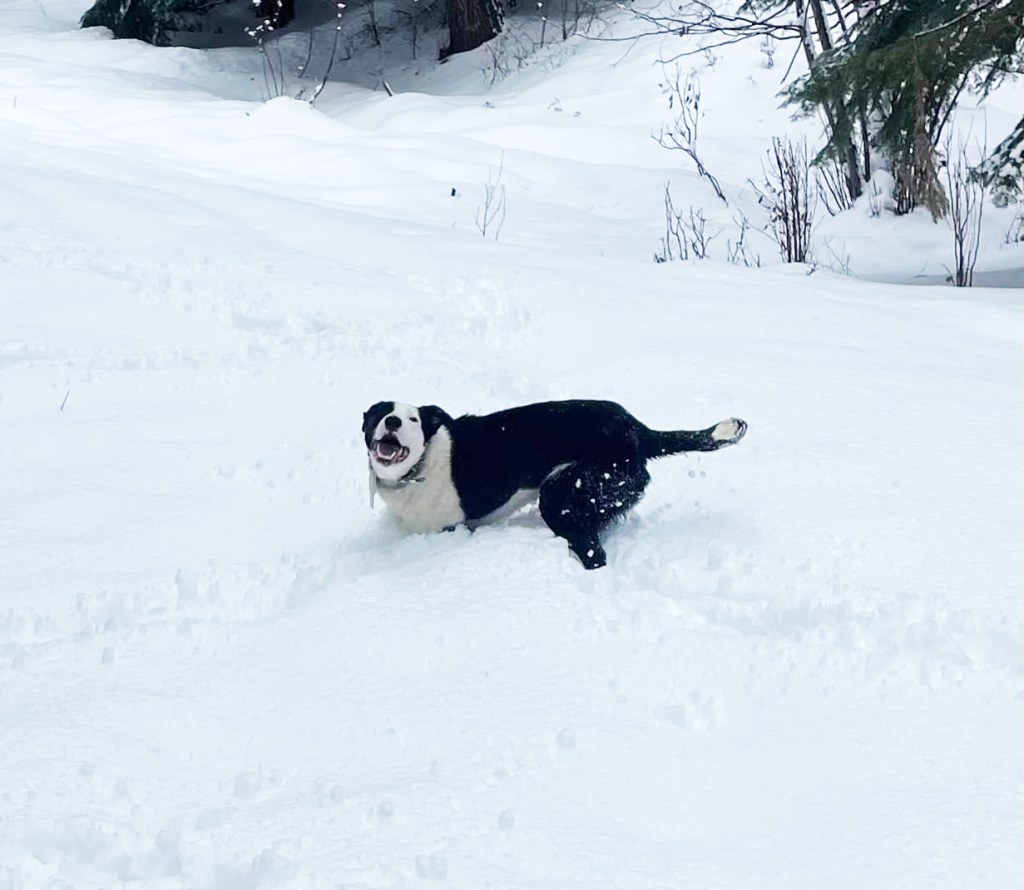‘Kind of an eerie feeling’: Rancher describes finding dog killed by wolves
Published 12:00 pm Tuesday, February 7, 2023

- Dodge, a 2-year-old border collie, was killed by wolves on Feb. 2 on the Lay Ranch near Medical Springs.
Coleman Lay has watched wolves, has tracked their prints in the snow, has heard them howling in the night from his family’s ranch.
But he’s never seen anything like what was left of his border collie, Dodge.
And when he saw the bloody carcass, Lay, 30, the sixth generation of his family to raise cattle in the Medical Springs area about 20 miles northeast of Baker City since the 19th century, could think only of the seventh generation.
Because his son, who’s six, and daughter, who’s two, often play in the same area where Dodge and his litter mate, Jack, sleep in their kennel.
And where he found four to five sets of wolf tracks on the morning of Feb. 2.
“That’s 40 yards from my front door,” Lay said on Monday, Feb. 6. “It’s kind of an eerie feeling. My kids play out there every day. You don’t quite feel safe in your own home. It’s been a nightmare.”
The Oregon Department of Fish and Wildlife (ODFW) confirmed that wolves had killed Dodge, who was two.
“They didn’t eat him,” Lay said. “They flat out killed him.”
Last time he saw Dodge aliveLay got home late on Feb. 1, around 11 p.m., after checking on cows.
When he pulled his pickup into the driveway, Dodge and Jack were at his feet the moment he stepped down from the driver’s seat.
“I loved on them for a minute before parting ways,” he wrote in a post on his Facebook page.
Lay went to bed.
That night he was awakened once by Dodge and Jack barking a few times.
But that wasn’t unusual.
The dogs occasionally bark if they hear a coyote in the distance, he said, or if a car on Highway 203 passes slowly.
Lay said that although he has tried to convince Dodge and Jack to sleep in the mud room of his home, the dogs would whine until they were let out. They sleep in a kennel equipped with a heat lamp and warm bedding.
The next morning Lay went out around 5:30 a.m. to warm up his pickup.
Only one dog was there — Jack.
And Jack, rather than his normal enthusiastic greeting, was next to the front door, acting as though he was scared.
“I kind of thought that was odd,” Lay said.
A skiff of snow had fallen in the night, and Lay quickly noticed four or five sets of wolf tracks in his front yard.
“I knew things weren’t going to turn out too well,” he said.
Lay found Dodge soon after.
Multiple groups of wolves in the area
Dodge’s death was the most recent in a series of confirmed wolf attacks in the area where Baker and Union counties meet, in the foothills of the Wallowas.
In separate incidents in January, wolves killed one yearling calf and injured another on a ranch not far from Lay’s, according to ODFW. Those attacks happened about 155 feet from a house.
The agency has also confirmed a new group of wolves in the Catherine Creek area north of Medical Springs.
Brian Ratliff, district wildlife biologist at ODFW’s Baker City office, said three groups of wolves, including a group of eight, had been in that area this winter based on photographs and data from tracking collars on some of the wolves.
One of the groups, though, has recently moved out of the area based on GPS collar data.
Lay said the situation is worrisome, particularly with calving season underway on most ranches, including his own.
“That’s way too many wolves in one area,” Lay said. “You’re looking in all directions. It’s an uphill battle.”
Ratliff agreed that the “perfect storm” is possible in the area, with wolves present during calving season.
Ranchers can shoot and kill wolves that are in the act of attacking, or threatening, livestock or working dogs such as Dodge.
But Lay said that scenario is so unlikely that the provision in Oregon law is all but meaningless.
“Those things are so smart, you just don’t see it (attacks in progress),” he said. “You’re just following their tracks and see what they’ve killed.”
He said wolves often attack livestock or dogs at night.
“You have to sleep at some point in time,” he said.
Lay said he’s tried nonlethal methods to deter wolves, such as maintaining a human presence around his cattle and burying cattle carcasses to avoid attracting wolves.
But he said the wolves don’t seem especially concerned about being near people, citing both the attack on Dodge and on the nearby ranchers’ calves, both of which were close to a home.
“They’re kind of used to it,” Lay said of wolves.
Ratliff said most ranchers in the area are taking steps to avoid unduly attracting wolves.
He said one rancher has offered the use of his backhoe to bury carcasses.
Seeking a new strategy
Lay said that although he dislikes wolves, he expects that he’ll have to deal with the predators for the foreseeable future.
He understands that some people like wolves, are entranced by the prospect of seeing them, or hearing them howl.
“Wolves aren’t going away,” Lay said.
But he believes the state needs to come up with a more effective way to manage wolves — one that helps avoid situations like the one he and his neighbors are dealing with, when multiple groups of wolves are congregating in a relatively small area.
He encourages people to lobby their lawmakers and otherwise advocate for what he considers a more equitable wolf management strategy.
“The squeaky wheel gets the grease,” Lay said. “Maybe if there’s a loud enough outcry.”
That’s also why he decided to post about his experience on Facebook, and include graphic photos of Dodge’s carcass.
“It made me sick to make a post on Facebook about my dog,” Lay said. “But I thought it was a wake-up call. Something’s got to be done.”
Dodge’s death was not only traumatic for the Lay family, but it also showed that wolves don’t only kill cattle on remote grazing allotments miles from the nearest home.
“This was a pet, and a part of the family,” he said. “Lots of people have dogs. This hits closer to home, it resonates with more people.”
Lay emphasized that he harbors no anger about local ODFW employees, the ones who end up examining the carcasses of cattle and, in some cases, working dogs.
“Their hands are tied,” Lay said.
Lay elaborated on his feelings about losing Dodge in his Facebook post.
“I’d rather lose a load of cattle before losing a ranch dog who is part of the family. Ranchers and cattleman rely on these dogs. Working dogs are not just something you can easily replace. Many hours and days are spent molding these dogs to work and handle cattle.”
Lay also addressed people who are happy that wolves have returned to Oregon after being extirpated from the state decades ago.
The wolves here now have their origin in animals the federal government released in Idaho, Montana and Wyoming starting in 1994. The first confirmed wolf migrated into Oregon in 1999, spending most of its time in Baker and Grant counties. There are more than 175 wolves in Oregon now, with the largest percentage in Northeastern Oregon.
Lay wrote in his Facebook post:
“Our state lawmakers want to make decisions for all of us on the opposite side of the state & have no clue the impacts it has on our lives. I suggest before they approve their next “Science Experiment” they get to have the chance to sit down with their kids and explain to them why their family dog isn’t coming home.”
“It made me sick to make a post on Facebook about my dog. But I thought it was a wake up call. Something’s got to be done.”
— Coleman Lay, Medical Springs rancher





